DOK – Democracy is OK
„Ja, zwykły, szary człowiek, taki jak wy, wzywam was wszystkich – nie czekajcie dłużej. Trzeba zmienić tę władzę jak najszybciej, zanim doszczętnie zniszczy nasz kraj; zanim całkowicie pozbawi nas wolności”. – Piotr Szczęsny, "szary człowiek" (19.10.2017)
Living in the past
Polish version
Brendan Jackson

While many of the new generation might listen to the music of Vader and Behemoth, they also have a conservative view, men more so than women in my experience. Save, invest in property, a nice car, have a holiday abroad, get married, work hard, talk about family values, moan about foreign influences. Who cares if they log Bialowieza forest; they can grow more trees. Changes in the constitution? For a better Poland, surely? Like Mulder in the X-Files, they ‘want to believe’. In something. Anything.
On Ulica Krakowskie Przedmiescie, the Madonna of Passau stands opposite the Polish Film Institute. The second oldest monument in the city, she remains as inscrutable as ever. What things she has witnessed. The street on either side of her looks much the same as ever, busy with students and tourists, cleaner than it used to be. The Old Town is a short walk away, in the other direction the Presidential Palace, then the University, itself over 200 years old. To promenade along this street is to pass though many layers of history. In 1683 this particular Madonna was sculpted by a Venetian to commemorate the victory of King Jan III Sobieski over the Turks at Vienna. “We came, we saw, and God conquered,” wrote Sobieski to Pope Innocent XI. The statue of Madonna is of quiet modest proportions, tiny compared to other devotional monuments and symbols. (Today Sobieski is also a premium brand vodka.)
In western Poland, you will find the tallest statue of Christ in the world, arms outstretched. Tallest by virtue of the gilded crown upon his head, he rises above a former cabbage field at Świebodzin, a small town of 21,000. Made of concrete and fibreglass, it was the dream of a local priest. Built with private donations, it was completed in 2010 and is now a popular site of pilgrimage. Standing at 52.5 metres, if we include the pedestal, it is not as tall as the building in Warsaw originally known as the Joseph Stalin Palace of Culture and Science, at 237 metres. Yuri Gagarin, standing on the viewing platform of the 30th floor of this iconic structure, is reported to have said: How far to the earth is it from here? Nowadays you may be more likely to find someone looking down, crossing themselves and then asking if it is possible, on a clear day, to see as far as the dome of St. Peters.
When I first came to Poland, as the 20th century ended, it seemed a familiar place, despite the decades of Communism that divided us. I had grown up in an industrial Midlands town in England, where there were many Poles who arrived after the end of the Second World War as Displaced Persons. Most came from the Eastern Settlements that were no longer within Poland’s territory, Wilno, Brest, Lwow and the villages and provinces in-between. Many had been deported to Siberian labour camps and resolutely hated everything to do with Russia. They sent food packages to distant cousins in Poland. As late as 2008, I was asked by one such elderly lady to take a package to old gentleman in Nałęczów, which contained Kelloggs cornflakes, chocolate biscuits and tea bags. She was worried I would be stopped at the border and the gifts confiscated. When I first arrived in Warsaw, I remember someone from the British Council saying how much he disliked the place, it reminded him of Manchester in the 1970’s. He dismissed it as grimy, grey, industrial, depressing. You can see why they need to drink vodka all the time, he said, too much drinking to the mirror, without beauty (borrowing from Czeslaw Milosz’s I Sleep a Lot). But I saw something different – a proud tenacity and enthusiasm, a tough veneer, a warm heart, restlessness.
My family came originally to the UK from Ireland; the Poland I saw then reminded me of the Ireland my family had left behind. So many years of economic stagnation under the dead weight of the civil-war generation who were still in power, old men who had failed in their promises to make a prosperous and self-sufficient country. As they would say back in Ireland, ‘Sure enough, they bolloxed up’, meaning they made a complete mess of it. The Catholic Church had a stranglehold on the country. They proclaimed: ‘The family that prays together stays together.’ It was the height of respectability to have a priest in the family or a daughter a nun. You would find members of Opus Dei standing at the back of every church service, on a recruiting mission (even in England). When the Minister of Health proposed to introduce a Mother and Child Scheme in 1951, which would provide free state-funded healthcare for all mothers and children aged under 16, he was summoned to the palace of the Archbishop of Dublin. There he was read a letter that was about to be sent to parliament. It stated ‘…they [the Archbishops and bishops] feel bound by their office to consider whether the proposals are in accordance with Catholic moral teaching’ and ‘Doctors trained in institutions in which we have no confidence may be appointed as medical officers … and may give gynecological care not in accordance with Catholic principles.’ The Church was concerned that women should know their place and suggesting that they might benefit from health education was going too far. God forbid that they might seek advice on contraception! (Note that as late as 1990 Dublin’s Virgin Megastore was fined £500 for selling condoms.) The government of the day withdrew the scheme, the humiliated minister resigned. Nevertheless, here began a questioning of traditional subservience of believers to the Church. Over half a million people left the Emerald Isle in the 1950’s, most of them young and the majority of them women, seeking a far less repressive life, lured by the attraction of urban life versus the declining rural one. By the end of the decade there were less than 3 million people left in Ireland.
In Warsaw, I became acquainted with the expression: „Socjalistyczna stolica, miastem każdego obywatela: robotnika, chłopa i pracującego inteligenta” (the socialist capital city for every citizen: worker, peasant and intellectual). On one of my first visits, I was shown the 1952 film ‘Adventure in Mariensztat’, about the reconstruction of the destroyed city by enthusiastic workers. The film begins amid the ruins, as building materials are transported to the capital. Young people in folk costume crowd onto a convoy of trucks, accompanied by accordionists. They are singing about how they will rebuild the city, and bring young ideas: ‘Tomorrow we will be able to defend what we create today! It’s the youth coming, youth, youth, and they sing, for it’s the youth who creates the world!’
Back in 2000, the energy of young people was palpable, a hunger for knowledge and a need to embrace the world. Yet they were suspicious of collective action, of political manipulation and chicanery. On the other hand, there were those who expressed nostalgia for PRL days, when things were less complicated, when the state looked after you, everyone had a job and a place. The reconstruction of Warsaw, a socialist miracle of a kind, seemed far far away in this new world of free market capitalism, which saw Warsaw remade over again. But the Warszawka in their luxury apartments only represent a small part of the country and the further I traveled outside the capital city, the deeper into a common past I seemed to go. For some years I kept a blog, primarily on the subject of drinking vodka, on journeys through Poland. It took me to not the usual places, beyond the familiar art world or academia. Back, you might say, to the Fifties. Then back to the future.
As the EU enlarged eastwards, many of the youth of Poland left. Around two million Poles, half of them university graduates, migrated to the UK, looking for better opportunities. Many of them commented on how their leaving eased the unemployment problem back home. Those young people who stayed in Poland seemed to embrace the re-emergence of older ideas. In 2008, in Kraków, I witnessed a small but disturbing march of the ONR – a Polish nationalist political party from the 1930’s, which was recreated in the 1990’s. Deriving its philosophy from fascist models, the young people wore Brownshirts, used Nazi salutes, and carried a banner that read: Niesiemy Polsce Odrodzenie. My Nowe Pokolenie. We bring Poland revival. We, the New Generation. Members of the British National Party stood by, admiring the spectacle. On the other side of the street, seperated by riot police, anarchists shouting No to Fascists!
While many of the new generation might listen to the music of Vader and Behemoth, they also have a conservative view, men more so than women in my experience. Save, invest in property, a nice car, have a holiday abroad, get married, work hard, talk about family values, moan about foreign influences. Who cares if they log Bialowieza forest; they can grow more trees. Changes in the constitution? For a better Poland, surely? Like Mulder in the X-Files, they ‘want to believe’. In something. Anything. A conspiracy theory even, falling back on past glories, imagined or otherwise, patriotism becoming confused by nationalism, growing hostility to anything from the outside, wherever that might be, a perspective empowered by the new government, though the signs have been there for some time.
In April 2010, on Ulica Krakowskie Przedmiescie, five days after the Smolensk air crash, a group of scouts erected a cross outside of the Presidential Palace. That summer in Warsaw a group known as The Defenders of The Cross, gathered to oppose moving the cross to a nearby church. In the days before the date set in August when the cross was to be relocated, there were increasingly vocal protests and clashes with police. Secular counter protesters arrived armed with cuddly toys, a rocking horse and a cross made from beer cans, demanding the legitimacy of these symbols also be recognised. The Defenders, armed with crucifixes and rosaries, prayed and sang hymns around the cross, guarding it 24 hours a day. They made wilder and wilder claims about the Prime Minister conspiring with Putin to kill the President. The police erected barriers to keep the two sides apart. It became a media event.
It was odd to hear abuse hurled at the priests and scouts who came to make a commemoration and relocate the cross. The Defenders waved Polish flags and shouted out at them: ‘Communist sympathizers! Satanists!’ There was an announcement that the cross would not be moved that day. The evening television news headline was Krzyż Stał, Krzyż Stoi/ The cross stood, the cross stands still. Later, as the vigil continued into the night, another crowd gathered, many there to make fun of the Defenders. There are a few undignified chaotic scenes and arrests. One of the supporters of the Defenders was taken away for making threatening gestures with an umbrella. Some proclaimed they had been miraculously cured of various disabilities. A woman cried out that she was cured of cancer. One man asserted to a journalist the supremacy of Latin culture over Byzantium culture, at which point I myself was lost for words and needed a drink. Others argued that the protest was politically organised by the dead President’s supporters whose brother, Jarosław Kaczyński, was a vocal opponent of the move. The Defenders defended, the media reported, onlookers looked on, the arguments were endless. Across the street, people crowded into the popular 24 hour vodka bar, gazed into the bottom of a vodka glass and wondered how this was all going to end.
On the wall of the nearby Ministry of Culture hung a piece of cardboard on which someone had written:
I voted for Lech K!!!
He was my president (unfortunately weak in my opinion)
NO!!!
To cross in front of the palace
No to the radicals
No to Polish-Polish war
No to Rydzyk (sect)
No for the politics of Jarosław K.
Yes to a memorial plaque
No for Duck Fascism!
I was reminded of something Gombrowicz wrote a long time ago when asked if Catholicism in Poland was as fervent now as it was before. He said that today’s Poland is a piece of stale bread, which breaks into two halves with a snap; the believing and the non-believing.
Yet I can still look at Poland with curiosity and admiration, share a glass of vodka with the best and worst of them, but aspects of it deeply disturb me – those that promote fear, insecurity and intolerance, those who give a standing ovation to Members of Parliament who say ‘The good of the nation is above the law’, those who wish to narrow the heroic Polish character, wishing to exclude any or all of the following; Jews, homosexuals, lesbians, immigrants, feminists, advocates of human rights, pro-Europeans, environmentalists, vegetarians, even cyclists. Perhaps Venetian sculptors would be particularly unwelcome these days.
Brendan Jackson is an artist from West Bromwich, UK, who has worked on projects in Poland over a number of years.
Gallery © Brendan Jackson
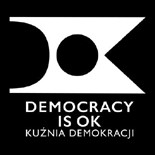
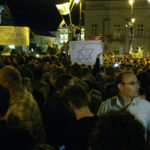
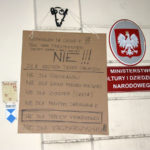
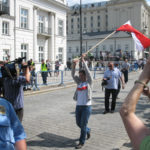
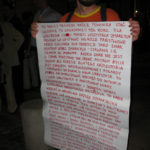

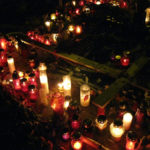
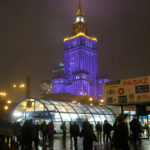
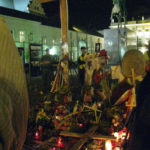
Najnowsze komentarze